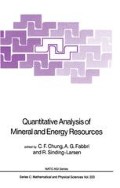Abstract
Point processes are models for point-like objects such as trees in a forest and earthquake occurrences in space-time. They are used to produce precise descriptions of point patterns. The basic types of pattern are described together with informative graphical summaries.
Access this chapter
Tax calculation will be finalised at checkout
Purchases are for personal use only
Preview
Unable to display preview. Download preview PDF.
References
Appleyard, S.T., Witkowski, J.A., Ripley, B.D., Shotton, D.M. and Dubowitz, V. (1985). ‘A novel procedure for pattern analysis of features present on freeze-fractured plasma membranes’. J. Cell Sci. 74, 105–117.
Baddeley, A.J. and Silverman, B.W. (1984). ‘A cautionary example on the use of second-order methods for analyzing point patterns’. Biometrics, 40, 1089–1093.
Bennett, R.J. and Haining, R.P. (1985). ‘Spatial structure and spatial interaction: modelling approaches to the statistical analysis of geographical data (with discussion)’. J. Roy. Statist. Soc. A 148, 1–36.
Broadbent, S. (1980). ‘Simulating the ley hunter (with discussion)’. J. Roy. Statist. Soc. A 143, 109–140.
Clark, P.J. and Evans, F.C. (1954). ‘Distance to nearest neighbour as a measure of spatial relationships in populations’. Ecology 35, 445–453.
Cox, T.F. (1979). ‘A method for mapping the dense and sparse regions of a forest stand’. Applied Statistics 28, 14–19.
Davis, J.C. (1973). Statistics and Data Analysis in Geology. Wiley, New York.
Deffeyes, K.S., Ripley, B.D. and Watson, G.S. (1982). ‘Stochastic geometry in petroleum geology’. Math. Geol. 14, 419–432.
Diggle, P.J. (1979). ‘On parameter estimation and goodness-of-fit testing for spatial point patterns’. Biometrics 35, 87–101.
Diggle, P.J. (1981). Some graphical methods in the analysis of spatial point patterns. In Interpreting Multivariate Data (ed. V. Barnett), Wiley, Chichester, 55–73.
Diggle, P.J. (1983). Statistical Analysis of Spatial Point Patterns. Academic Press, London.
Fiksel, T. (1984). ‘Estimation of parameterized pair potentials of marked and non-marked Gibbsian point processes’. Elekt. Inf. Kybern. 20, 270–278.
Glotzl, E. and Rauchenschwandtner, B. (1981). ‘On the statistics of Gibbsian processes’. Lect. Notes Statistics 8.
Gudmundsson, G. and Saemundsson, K. (1980). ‘Statistical analysis of damaging earthquakes and volcanic eruptions in Iceland from 1550–1978’. J. Geophys. 47, 99–109.
Guild, F.J. and Silverman, B.W. (1978). ‘The microstructure of glass fibre reinforced polyester resin composites’. J. Microscopy 114, 131–141.
Hanisch, K.-H. and Stoyan, D. (1979). ‘Formulas for the second-order analysis of marked point processes’. Math. Oper. Stat, ser Stat. 10, 555–560.
Harkness, R.D. and Isham, V. (1983). ‘A bivariate spatial point pattern of ants’ nests’. Applied Statistics 32, 293–303.
Kelly, F.P. and Ripley, B.D. (1976). ‘A note on Strauss’ model for clustering’. Biometrika 63, 357–360.
Kendall, D.G. (1981). ‘The statistics of shape’. In Interpreting Multivariate Data (ed. V. Barnett), Wiley, Chichester.
Kendall, D.G. (1985). ‘Exact distributions for shapes of random triangles in convex sets’. Adv. Appl. Prob. 17, 308–329.
Kendall, D.G. and Kendall, W.S. (1981). ‘Alignments in 2-dimensional random sets of points’. Adv. Appl. Prob. 12, 380–424.
Lotwick, H.W. and Silverman, B.W. (1982). ‘Methods for analysing spatial processes of several types of points’. J. Roy. Statist. Soc. B 44, 406–413.
Ogata, Y. and Tanemura, M. (1981). ‘Estimation of interaction potentials of spatial point patterns through the maximum likelihood procedure’. Ann. Inst. Statist. Math. B 33, 315–338.
Ogata, Y. and Tanemura, M. (1984). ‘Likelihood analysis of spatial point patterns’. J. Roy. Statist. Soc. B 46, 496–518.
Ohser, J. (1983). ‘On estimators of the reduced second moment measure of point processes’. Math. Oper. Statist, ser. Statist. 14, 63–71.
Ohser, J. and Stoyan, D. (1981). ‘On the second-order and orientation analysis of planar stationary point processes’. Biom. J. 23, 523–533.
Ohser, J., Ripley, B.D. and Stoyan, D. (1986). ‘On the efficiency of edge corrections for spatial point processes’. Unpublished ms.
Penttinen, A. (1984). ‘Modelling interactions in spatial point patterns: parameter estimation by the maximum likelihood method’. Jyväskylä Studies in Computer Science, Economics and Statistics 7.
Ripley, B.D. (1976). ‘The second-order analysis of stationary point processes’. J. Appl. Prob. 13, 255–266.
Ripley, B.D. (1977). ‘Modelling spatial patterns (with discussion)’. J. Roy. Statist. Soc. B 39, 172–212.
Ripley, B.D. (1981). Spatial Statistics. Wiley; New York.
Ripley, B.D. (1984a). ‘Edge corrections for spatial processes’. In Stochastic Geometry, Geometrical Statistics, Stereology (eds. R.V. Ambartzumian and W. Weil). Teubner-Texte; Leipzig, 144–153.
Ripley, B.D. (1984b). ‘Spatial statistics: developments 1980–3’. Int. Statist. Rev. 52, 141–150.
Ripley, B.D. (1986). ‘Statistics, images and pattern recognition’. Canad. J. Statist. 14, 83–111.
Ripley, B.D. and Silverman, B.W. (1978). ‘Quick tests for spatial regularity’. Biometrika 65, 641–642.
Silverman, B.W. (1981). Density estimation for univariate and bivariate data’. In Interpreting Multivariate Data (ed. V. Barnett), Wiley, Chichester, 37–53.
Silverman, B.W. (1985). Density Estimation. Chapman and Hall, London.
Stoyan, D. (1983). ‘Quantification of correlations of geological line systems, with applications in the interpretation of remote sensing images’. In Methods of Instrumental and Digital Image Analysis for Geological Problems, Z. Physik der Erde, Potsdam.
Upton, J.G. and Fingleton, B. (1985). Spatial Data Analysis by Example. Volume 1. Point Pattern and Quantitative Data. Wiley, Chichester.
Vere-Jones, D. (1978). ‘Space time correlations for micro earthquakes–a pilot study’. Suppl. Adv. Appl. Prob. 10, 73–87.
Author information
Authors and Affiliations
Editor information
Editors and Affiliations
Rights and permissions
Copyright information
© 1988 D. Reidel Publishing Company, Dordrecht, Holland
About this chapter
Cite this chapter
Ripley, B.D. (1988). Point Processes for the Earth Sciences. In: Chung, C.F., Fabbri, A.G., Sinding-Larsen, R. (eds) Quantitative Analysis of Mineral and Energy Resources. NATO ASI Series, vol 223. Springer, Dordrecht. https://doi.org/10.1007/978-94-009-4029-1_18
Download citation
DOI: https://doi.org/10.1007/978-94-009-4029-1_18
Publisher Name: Springer, Dordrecht
Print ISBN: 978-94-010-8288-4
Online ISBN: 978-94-009-4029-1
eBook Packages: Springer Book Archive

